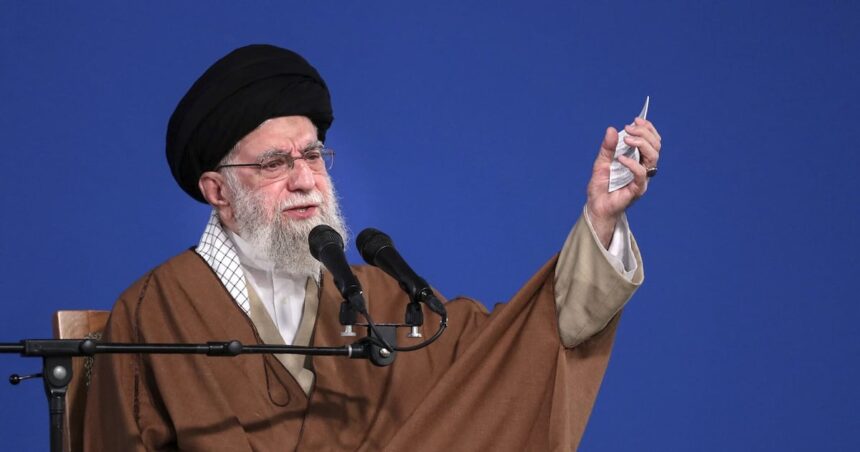Iran’s supreme leader Ayatollah Ali Khamenei warned on Wednesday that any further Israeli aggression would trigger a more powerful retaliation than the missile barrage Tehran launched against Israel earlier this month. The statement comes amid escalating tensions that have pushed the Middle East closer to a regional war.
“If the Zionist regime or its supporters show any aggression against our interests, they will face a stronger response,” Khamenei declared during a ceremony commemorating the anniversary of Prophet Muhammad’s appointment to prophethood. The 85-year-old leader, dressed in his customary black turban and robes, stood firm before thousands of supporters chanting anti-Israeli and anti-American slogans.
I’ve been tracking the regional response since Iran’s April 13 missile assault, which Israel claimed caused minimal damage thanks to its air defenses and assistance from allied nations. During my recent conversations with regional security analysts in Beirut, many expressed concern that we’re witnessing a dangerous new phase of brinkmanship.
“Tehran carefully calibrated its response to be significant enough to save face domestically while attempting to avoid triggering a full-scale war,” explained Dina Esfandiary, senior adviser for the Middle East at the International Crisis Group. “But the risk of miscalculation remains extraordinarily high.”
The April attack marked Iran’s first direct military strike on Israeli territory, launched in retaliation for Israel’s bombing of Iran’s embassy compound in Damascus on April 1. That strike killed seven Iranian Revolutionary Guards officers, including two senior commanders.
Israeli officials have repeatedly threatened to respond to Iran’s missile attack, though the timing and scale remain uncertain. Prime Minister Benjamin Netanyahu’s war cabinet has been deliberating various options while simultaneously continuing military operations in Gaza and facing increasing pressure from Hezbollah along Israel’s northern border.
According to data from the Armed Conflict Location & Event Data Project, cross-border exchanges between Israel and Hezbollah have resulted in over 370 deaths since October, with most casualties on the Lebanese side. During a visit to the northern border last week, I witnessed entire villages evacuated and farmland abandoned as residents fled the daily exchanges of fire.
The United States has attempted to de-escalate tensions, with Secretary of State Antony Blinken urging restraint during diplomatic shuttles across the region. “We don’t want to see this escalate,” Blinken stated during a press conference in Jordan. “We’re focused on containing this conflict while still supporting Israel’s right to defend itself.”
Yet Washington’s influence appears limited. A European diplomat in Tehran, speaking on condition of anonymity, told me that Iranian officials believe they successfully demonstrated their military capabilities while establishing new red lines. “They’re signaling they won’t tolerate attacks on Iranian sovereign territory or high-ranking officials without consequence,” the diplomat said.
Iran’s missile arsenal represents one of its most significant military advantages. The Stockholm International Peace Research Institute estimates Tehran possesses thousands of ballistic missiles with ranges between 300 and 2,000 kilometers, capable of reaching Israel and U.S. military bases throughout the region.
Economic factors also loom large in Iran’s calculations. Despite crippling international sanctions, Iran’s oil exports have rebounded to approximately 1.5 million barrels per day, according to tanker tracking data compiled by Bloomberg. Any major military confrontation risks disrupting this vital revenue stream at a time when Iran’s economy is already struggling with inflation exceeding 40%.
“The threat of retaliation serves multiple purposes for the regime,” noted Ali Vaez, Iran Project Director at the International Crisis Group. “It deters future Israeli strikes while allowing the leadership to project strength to a domestic audience increasingly frustrated with economic hardships.”
For ordinary Iranians, the prospect of war adds another layer of anxiety to daily life. During phone interviews with Tehran residents, many expressed concerns about being caught in a conflict they feel powerless to influence.
“We’re trapped between sanctions and the threat of bombs,” said Mariam, a 34-year-old teacher who asked that only her first name be used. “Most people just want to live without constant fear.”
Meanwhile, humanitarian organizations warn that regional escalation could exacerbate already dire conditions. The International Rescue Committee reports that over 34,000 Palestinians have been killed in Gaza since October, with critical infrastructure destroyed and famine threatening large portions of the population.
The complex interplay of military posturing, diplomatic maneuvering, and domestic politics makes predicting the next moves difficult. Israeli officials maintain they must respond to Iran’s missile attack to maintain deterrence, while Tehran insists its actions were justified self-defense.
As tensions simmer, global powers have increased naval deployments to the region. The U.S. maintains significant military presence with the USS Abraham Lincoln carrier strike group recently joining the USS Theodore Roosevelt in the Mediterranean, representing a substantial show of force.
Whether these escalating threats translate into direct military action remains uncertain. What’s clear is that the region stands at a precarious crossroads, with millions of civilians caught in the balance of decisions made in capital cities thousands of miles from the potential front lines.






